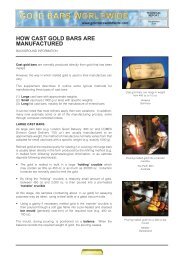Indian Gold Book:Indian Gold Book - Gold Bars Worldwide
Indian Gold Book:Indian Gold Book - Gold Bars Worldwide
Indian Gold Book:Indian Gold Book - Gold Bars Worldwide
You also want an ePaper? Increase the reach of your titles
YUMPU automatically turns print PDFs into web optimized ePapers that Google loves.
SUMMARY AND POSITIVE FINDINGS<br />
The amount of recycling is sensitive to gold price movements, the economic environment and personal stocks. In 1998, it<br />
appears to have been closer to 35%. In the first 6 months of 2002, due to the rise in the gold price, recycling is reported<br />
to have been 50% and more at times.<br />
Important points: Recycling is much higher than normally reported. A small increase in recycling will impact a lot more on<br />
net demand than on gross demand.<br />
Gross fabrication of jewellery<br />
When recycling is taken into account, the gross fabrication of gold jewellery increases dramatically. In 2001, when net<br />
fabrication was 583 tonnes, an indicative (and conservative) estimate of gross fabrication is 955 tonnes.<br />
Important points: Gross fabrication is much higher than normally reported. A fall in net fabrication (excluding scrap) does<br />
not necessarily imply a fall in gross fabrication (including scrap).<br />
Coin fabrication<br />
Anecdotal evidence suggests that coin fabrication may have been as high as 35 tonnes. Some <strong>Indian</strong> analysts believe it may<br />
have been more. The amount is an unresolved issue because there is no broad consensus among analysts.<br />
Important points: Coins are widely viewed as intermediate products. More than 50% is expected to be converted into<br />
jewellery over time.<br />
Net bar hoarding<br />
Anecdotal evidence suggests that the annual increase in net bar hoarding may have been small in recent years. In 2001, it<br />
may have been as low as 20 tonnes (i.e. 3% of imports). There are several reasons. Owning TT bars is widely associated<br />
with the underground economy. Jewellery is generally viewed as the best way to own gold.<br />
There is speculative trading in TT bars, but residual net bar hoarding is regarded as low. Its extent is also reported to have<br />
fallen since 1998. Significant quantities of TT bars may be bought to “park” black money, but retailers observe that the bars<br />
would probably be held for a short period and would enter the jewellery market.<br />
Important point: The amount of net bar hoarding is an unresolved issue because there is no broad consensus among<br />
analysts.<br />
Total market<br />
The total market does not make structural sense, and trade comments also do not make sense, unless the extent of gross<br />
demand is taken into account.<br />
The indicative estimate of gross demand in 2001 is 1,053 tonnes. This is about 50% higher than normally reported.<br />
It puts the high tonnages of industrial fabrication (4%) and coin fabrication (3%), as well as net bar hoarding (2%) into<br />
perspective. Jewellery accounts for around 90% of the market.<br />
It explains why there are around 300,000 gold jewellery outlets, 3 million active goldsmiths and ancillary workers, and 10,000<br />
refiners.<br />
It explains why net demand (i.e. imports) was able to fall so much more than gross demand in the first 6 months of 2002.<br />
It also explains why so many <strong>Indian</strong> trade entities observe that the jewellery market is so much larger than normally<br />
reported in the West.<br />
Above ground stocks<br />
Stocks at the end of 2001 are recorded at approximately 12,000 tonnes. 45% of the stock (5,300 tonnes) has been acquired<br />
since 1990.<br />
The 181 million families in India hold an average of 64 grammes of fine gold (around 85 grammes of carat gold). As 26%<br />
of the population is below the poverty line, the top 50% would obviously hold substantially more than the average. At least<br />
90% is held as gold jewellery.<br />
Anecdotal evidence (at this time) suggests that around 5% may be held in the form of coins and bars. The net<br />
accumulation of coins and bars is considered low as much appears to have been converted into jewellery. In addition, it<br />
was illegal to fabricate coins or own bars during the <strong>Gold</strong> (Control) Act period.<br />
AN INTRODUCTION TO THE INDIAN GOLD MARKET 19

















